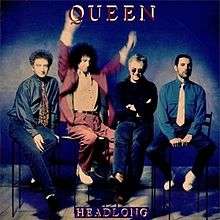Headlong (song)
| "Headlong" | |||||||
|---|---|---|---|---|---|---|---|
 | |||||||
| Single by Queen | |||||||
| from the album Innuendo | |||||||
| B-side |
"Mad the Swine" "All God's People" | ||||||
| Released |
14 January 1991 (US) 13 May 1991 (UK) | ||||||
| Format | 7"/12", CD, cassette | ||||||
| Recorded | early 1989 – mid 1990 | ||||||
| Genre | Hard Rock | ||||||
| Length | 4:38 | ||||||
| Label |
Parlophone (Europe) Hollywood (North America) | ||||||
| Writer(s) |
Queen (Brian May) | ||||||
| Producer(s) | Queen and David Richards | ||||||
| Queen singles chronology | |||||||
| |||||||
| |||||||
"Headlong" is a song by the British rock band Queen. It was released as the third single from Queen's 1991 album Innuendo.
The song was written by Queen guitarist Brian May, who intended to record it for his then-upcoming solo album Back to the Light (1992), but when he heard Queen lead singer Freddie Mercury sing the track, he allowed it to become a Queen song.
The song was the first single to be released in the United States under their contract with Hollywood Records on 14 January 1991, though it was not released in the United Kingdom for another four months (the first single in the United Kingdom was "Innuendo", which Hollywood eventually released in the US as a promotional single for radio stations). The song charted on the Hot Mainstream Rock Tracks chart in the United States at #3. The line "And you're rushin' headlong" from the chorus is somewhat lifted from the second verse of "Breakthru", a single from Queen's previous album The Miracle, which contains the lyrics "I wanna rush headlong into this ecstasy".
The cover of one of the CD singles is inspired by Grandville illustrations, as are all of the other singles from the album.
Promotional video
The music video for "Headlong" was one of the final Queen videos shot with lead singer Freddie Mercury, some 12 months before his death from AIDS, though it was actually shot before the "I'm Going Slightly Mad" video (released as the second single in the UK). The video showed the band in the studio performing the song (in a stage-like setup), as well as shots of the band working in the studio. The version of the song in the video includes an extra short section after the second chorus not released in any audio format to date.
The performance footage (Mercury wearing a yellow sweater) and the studio footage (of Mercury wearing two different blue shirts) were shot in late 1990 at Metropolis Studios in London (the exterior of which is shown at the beginning and the end of the video). The footage were part of the Innuendo EPK filmed at Metropolis Studios at the end of 1990. This is also the last colour video of Freddie Mercury, whose health was declining due to the HIV virus which would claim his life on 24 November the following year. The next videos, I'm Going Slightly Mad and These Are the Days of Our Lives were recorded during February and May 1991 respectively, both in black-and-white.
Like all other videos for the Innuendo album, the "Headlong" clip was directed by Austrian director team DoRo, consisting of Rudi Dolezal and Hannes Rossacher, who had been regularly working for Queen since the video for the 1986 single "Friends Will Be Friends". They also directed the video to the only new output of the group as a three-piece, "No-One but You (Only the Good Die Young)", released in 1997.
Personnel
- Freddie Mercury - lead and backing vocals
- Brian May - electric guitar, piano, keyboards, drum programming, backing vocals
- Roger Taylor - drums, backing vocals
- John Deacon - bass guitar
Chart performance
| Chart (1991) | Peak position |
Total weeks |
|---|---|---|
| Canadian Singles Chart[1] | 25 | 11 |
| Dutch Singles Chart[2] | 43 | 8 |
| Irish Singles Chart[3] | 25 | 2 |
| UK Singles Chart[4] | 14 | 4 |
| U.S. Mainstream Rock Charts[5] | 3 | 10 |
References
- ↑ "Bienvenue au site Web BIBLIOTHÈQUE ET ARCHIVES CANADA | Welcome to the LIBRARY AND ARCHIVES CANADA website". Collectionscanada.gc.ca. Retrieved 2012-02-20.
- ↑ Steffen Hung. "Queen - Headlong". dutchcharts.nl. Retrieved 2012-02-20.
- ↑ Jaclyn Ward (1962-10-01). "The Irish Charts - All there is to know". Irishcharts.ie. Retrieved 2012-02-20.
- ↑ "UK Singles & Albums Chart Archive". Chart Stats. Retrieved 2012-02-20.
- ↑ "AllMusic". AllMusic. Retrieved 2012-02-20.
External links
- "Queen - Headlong (single) (1991)". Paulmcgarry.com.
